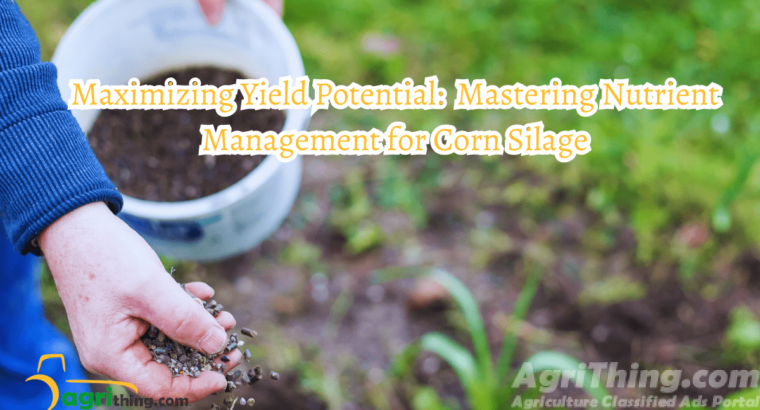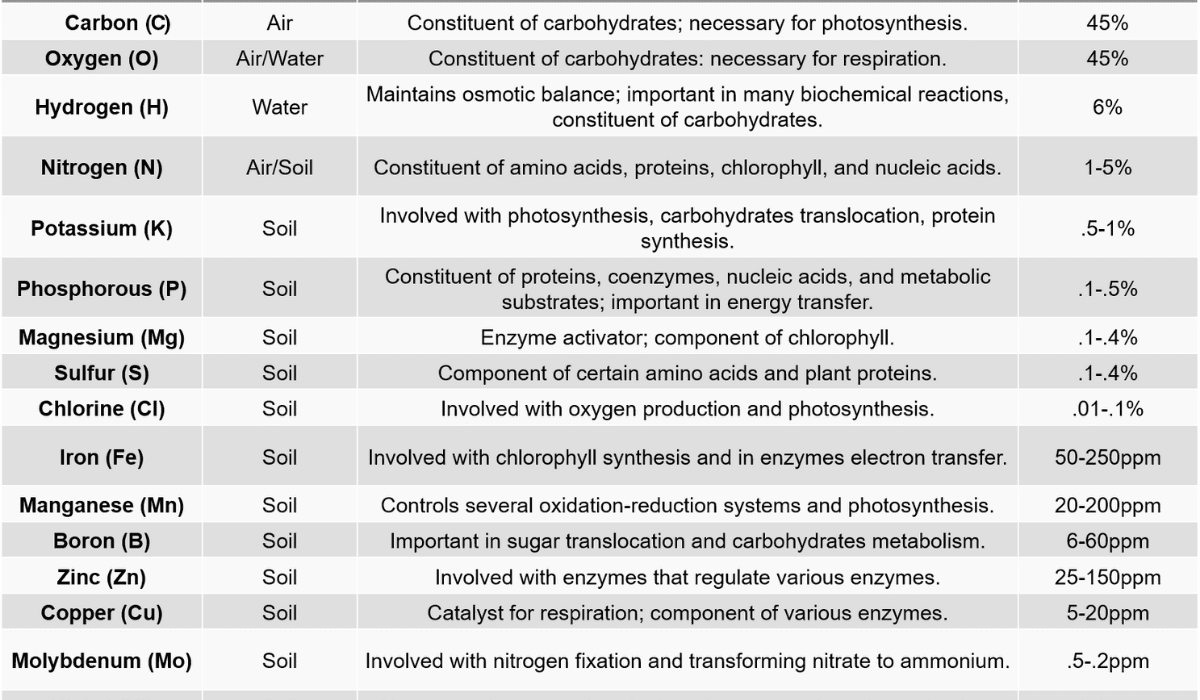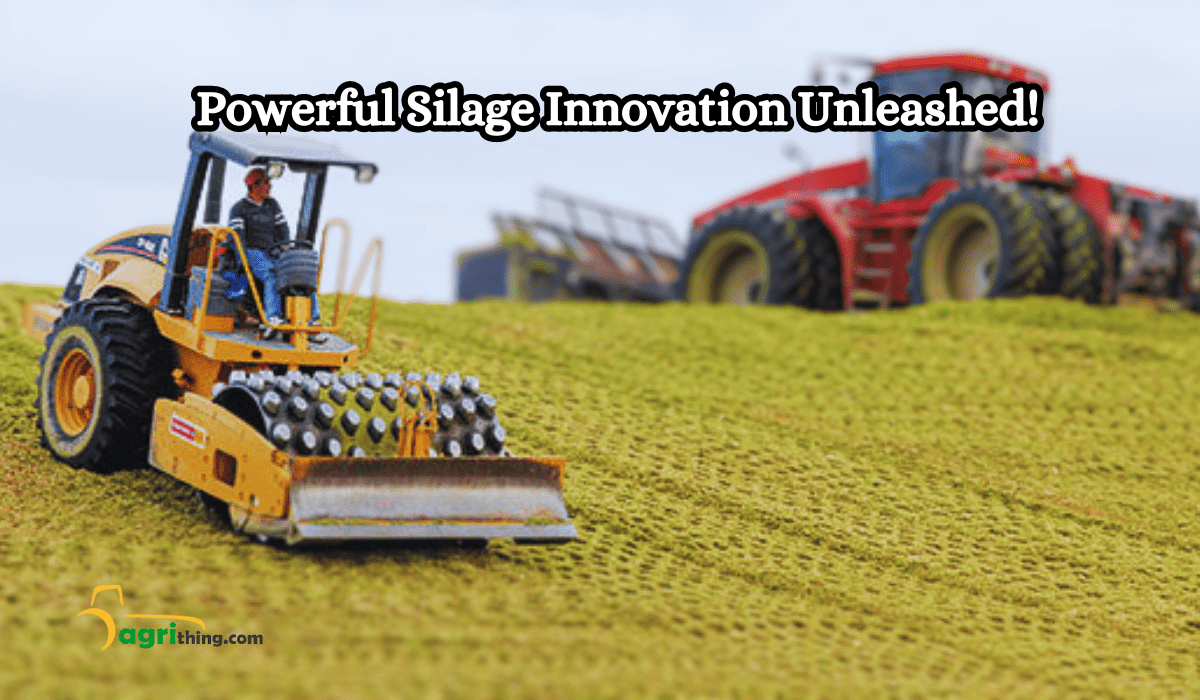Nutrient Management: Unlock Optimal Growth and Yield

Corn silage nutrient management is important for feeding animals. It is nutritious and easy for them to digest. It helps them grow and perform well. This article will explain how to take care of corn silage so that it provides the most nutrition and keeps animals healthy.
Table of Contents
Introduction
Livestock farmers know giving their animals a balanced and nutritious diet is crucial. Corn silage is made by fermenting chopped corn plants and is a great feed option. It has lots of energy and tastes good to animals. It’s a cheaper choice than regular crops and provides a steady supply of nutrients all year long. By corn silage nutrient management, farmers can make the animals healthier, improve how they digest their food, and make more money.
Importance of corn silage storage
Minimization of waste: Adequate storage reduces the risk of spoilage and deterioration of corn silage, minimizing feed losses and economic waste. Properly stored silage retains its nutrient content, allowing farmers to efficiently utilize their feed resources and optimize feed efficiency in livestock operations.


Understanding Corn Silage Nutrition
Analyzing the nutrient composition of corn silage through laboratory testing provides valuable information about its nutritional content. This includes assessing the levels of carbohydrates, protein, fiber, and minerals, which are essential for formulating balanced diets for livestock.
Evaluating the dry matter content of corn silage helps determine its moisture level and nutrient concentration. Adjusting the dry matter intake according to the livestock’s nutritional requirements ensures optimal feed utilization and prevents under or overfeeding.
The Benefits of Corn Silage
Corn silage is a highly nutritious and cost-effective feed option for livestock. It provides a concentrated energy source and protein, promoting healthy growth and productivity in animals.
The ensiling corn preserves nutrients and extends its shelf life, allowing farmers to store and use it throughout the year. This ensures a stable and consistent food supply for livestock, even during periods of scarcity or unfavorable weather conditions.
Effective Nutrient Management Strategies
Implementing soil testing and analysis helps determine the nutrient levels in the soil and allows for targeted fertilization. This enables farmers to apply fertilizers efficiently and appropriately, minimizing waste and potential environmental impacts.
Adopting conservation practices like nutrient management planning and proper timing of fertilizer application helps prevent nutrient losses and improve crop uptake. These strategies promote sustainable agriculture by reducing nutrient runoff into water bodies and minimizing nutrient pollution.
Boosting Feed Efficiency in Corn Silage
Regular animal performance monitoring and assessment, such as growth rates and feed conversion ratios, allows for adjustments in feed formulation and management practices. This continuous evaluation helps identify areas for improvement and fine-tune feed efficiency in corn silage-based diets.
Balancing the ration with other feed ingredients, such as protein sources and forages, helps optimize nutrient intake and digestion. A well-formulated diet that meets the specific nutritional requirements of the livestock can improve feed efficiency and overall performance.
Essential Silage Preservation Methods
Ensuring proper harvesting and timely forage ensiling is crucial for silage preservation. Harvesting at the correct moisture content, typically around 60-70%, and quickly packing the forage into a silo or bunker minimizes exposure to air and promotes anaerobic conditions necessary for fermentation.
Ensuring proper sealing and covering of the silo or bunker is crucial to prevent air and water ingress. Using plastic sheets or oxygen barrier films and securing the edges tightly creates a barrier that maintains anaerobic conditions and prevents spoilage
Optimal Forage Management Strategies
Regular forage inventory and analysis helps determine the quantity and quality of available forage. This information enables farmers to make informed decisions regarding forage allocation and supplementation, ensuring optimal nutrition for livestock
Implement proper grazing management practices and utilize effective harvesting and storage methods.
Exploring Corn Silage Varieties
Maturity: Corn silage varieties can be classified into early, mid, and full-season maturity types. Early maturity varieties have a shorter growing season and are suitable for regions with shorter growing seasons or for double-cropping. Mid and full-season varieties require longer growing seasons but often have higher yield potential.
Disease and Pest Resistance: It is important to select corn silage varieties with good resistance to common diseases and pests in your region. Resistance to diseases such as corn leaf blight, gray leaf spots, and stalk rots can help ensure a healthier crop and reduce the need for chemical interventions.


Maximizing Feed Efficiency: Harvesting
Maximizing feed efficiency during the harvesting process is crucial for optimizing the nutritional value and minimizing losses of corn silage.
Sealing and Covering: After filling the silo or bunker, it is essential to seal the corn silage to prevent oxygen exposure. Oxygen can lead to spoilage and nutrient losses. Cover the silo with an oxygen barrier film or use a well-sealed bunker cover. Regularly inspect the cover for any damage or holes and repair them promptly.
Effective Silage Storage Practices
Ensure proper compaction and sealing of the hay to minimize oxygen exposure and promote anaerobic fermentation, preventing spoilage and nutrient losses.
Regularly monitor and maintain the silage face to minimize air penetration and prevent heating, mold growth, and nutrient degradation.
Optimizing Farm Management for Efficiency
Implement precision agriculture technologies, such as GPS guidance systems and yield monitoring, to optimize field operations, reduce input waste, and improve overall farm efficiency.
Use data-driven decision-making by analyzing farm records, performance metrics, and cost-benefit analysis to identify areas for improvement, streamline processes, and allocate resources effectively.
Corn silage feed management
Adjust feeding rates: Calculate and adjust the appropriate feeding rates based on the animal’s requirements and the nutrient composition of the corn silage. Monitor animal performance and adjust feed amounts to achieve desired growth, milk production, or weight gain.
Corn silage fermentation process
Fermentation: Once the corn silage is packed, fermentation begins. The lactic acid bacteria naturally present in the plant material convert the sugars in the corn into lactic acid through anaerobic fermentation. This process lowers the pH, inhibits the growth of spoilage bacteria, and preserves the forage by preventing decay.
Maximizing feed efficiency in dairy cattle
Balanced ration formulation: Develop a balanced diet that meets the specific nutritional requirements of dairy cattle at different stages of lactation. Utilize high-quality forages, such as corn silage, and appropriate protein sources and supplements to optimize nutrient intake and utilization.
Optimal corn silage harvesting practices
Packing and compaction: Ensure proper packing and compaction of the harvested corn silage in the storage structure. Use heavy machinery to tightly pack the silage, removing as much oxygen as possible to create an anaerobic environment for fermentation.


Nutrient requirements for silage
The nutrient requirements for hay depend on the specific livestock being fed, their production stage, and their nutritional needs. Key nutrients to consider in silage diets include carbohydrates (energy source), protein (amino acids for growth and production), minerals (such as calcium and phosphorus), and vitamins. A balanced diet that meets these requirements ensures optimal nutrition and performance in animals consuming silage.
Nutrient composition of corn silage
Before delving into the intricacies of nutrient management, understanding corn silage’s composition is crucial. Corn silage is an excellent source of energy, protein, fibre, vitamins, and minerals, making it a well-rounded feed option for livestock. The energy content, measured in terms of digestible energy (DE) or metabolizable energy (ME), is a key consideration for farmers, as it directly influences animal performance. Additionally, corn silage is rich in carbohydrates, particularly starch, which provides a readily available source of energy for ruminants.
Maximizing feed efficiency
Feed efficiency is critical in livestock production, directly impacting overall profitability. Farmers can better convert feed into valuable products such as milk, meat, or eggs by improving feed efficiency. Efficient nutrient management is pivotal in maximizing feed efficiency, ensuring that animals receive the necessary nutrients to support growth, reproduction, and overall health
Factors influencing nutrient management in corn silage
Several factors influence nutrient management in corn silage production. Understanding these factors is essential for optimizing feed efficiency and maintaining a healthy herd. Factors such as planting density, hybrid selection, fertility management, and irrigation practices can significantly impact the nutrient composition of corn silage. Proper soil testing, crop rotation, and pest management also contribute to the harvested crop’s overall nutrient value and quality.
Determining optimal harvest time
Harvesting corn silage at the optimal time is crucial to ensure maximum nutrient content and feed efficiency. The ideal harvest time depends on maturity, moisture content, and nutrient composition. Monitoring the moisture content and performing kernel processing assessments are important in determining the optimal harvest window. Harvesting too early or late can result in suboptimal feed quality and reduced nutrient availability.
Silage storage and preservation techniques
Proper storage and preservation techniques are essential to maintain the nutrient value of corn silage throughout its storage period. Effective compaction and sealing of silage bags or bunkers minimize exposure to air, reducing the risk of nutrient degradation and mould formation. Adequate fermentation, achieved by maintaining the appropriate moisture level and adding a research-proven inoculant, ensures the preservation of nutrients and reduces the growth of undesirable bacteria.
Enhancing nutrient value through processing techniques
Processing techniques can further enhance the nutrient value of corn silage. Shredding or processing the corn plants before ensiling can improve digestibility by breaking down the plant’s structural components. Additionally, using a kernel processor can enhance starch availability, leading to better energy utilization by livestock. Farmers should consider their specific needs, equipment availability, and the target livestock species when deciding on the processing techniques to employ.
Balancing nutrient needs for livestock
Different livestock species have varying nutrient requirements, and it is crucial to balance the nutrient composition of corn silage accordingly. Dairy cows, for example, have high energy demands, requiring corn silage with adequate starch content. Beef cattle, on the other hand, benefit from corn silage with higher fibre levels to support rumen function. By understanding the specific nutrient needs of their livestock, farmers can tailor their corn silage management practices to optimize animal performance and health.
Utilizing additives and supplements
Additives and supplements can be utilized to enhance the quality and nutrient composition of corn silage. Research-backed additives, such as microbial inoculants or enzymes, can improve fermentation efficiency, nutrient digestibility, and animal performance. Supplements like minerals, vitamins, or specific amino acids can help address any nutrient deficiencies in the corn silage. However, consulting with a nutritionist or veterinarian before incorporating additives or supplements into the feeding program is crucial to ensure proper dosing and efficacy.
Monitoring and testing for nutrient content
Regular monitoring and testing of corn silage are essential to assess its nutrient content accurately. Analyzing the dry matter, starch, fibre, and protein content provides insights into the feed’s nutritional value. These tests enable farmers to adjust the feeding program and make informed decisions regarding supplementation or changes in feed rations. Utilizing the services of a reputable laboratory and establishing a regular testing schedule is crucial for effective nutrient management.
Managing nutrient runoff and environmental impact
Efficient nutrient management extends beyond the farm’s boundaries, encompassing environmental stewardship. Nutrients from corn silage, if not managed properly, can contribute to nutrient runoff and potential environmental pollution. Implementing best management practices such as proper manure management, buffer strips, and controlled application of fertilizers helps minimize nutrient runoff and protect water quality. Farmers should stay updated on local regulations and nutrient management and conservation practices recommendations
Implementing best practices for feed management
Efficient nutrient management extends beyond the farm’s boundaries, encompassing environmental stewardship. Nutrients from corn silage, if not managed properly, can contribute to nutrient runoff and potential environmental pollution. Implementing best management practices such as proper manure management, buffer strips, and controlled application of fertilizers helps minimize nutrient runoff and protect water quality. Farmers should stay updated on local regulations and nutrient management and conservation practices recommendations.
Case studies and success stories
Real-life case studies and success stories provide valuable insights into the practical application of corn silage nutrient management strategies. These stories highlight the benefits of implementing effective nutrient management practices, such as improved animal performance, reduced feed costs, and enhanced farm profitability. By learning from successful experiences, farmers can gain inspiration and knowledge to implement similar practices on their own farms.
Future trends and advancements
Efficient nutrient management extends beyond the farm’s boundaries, encompassing environmental stewardship. Nutrients from corn silage, if not managed properly, can contribute to nutrient runoff and potential environmental pollution. Implementing best management practices such as proper manure management, buffer strips, and controlled application of fertilizers helps minimize nutrient runoff and protect water quality. Farmers should stay updated on local regulations and nutrient management and conservation practices recommendations.
Conclusion
To sum up, taking care of the nutrients in corn silage nutrient management is important for making the animal feed work well and making the livestock perform their best. Farmers can do this by understanding what nutrients are in the corn silage, following the best ways to harvest, store, and process it, and thinking about what their animals need. This helps ensure the animals get a feed that has all the right nutrients and is of good quality. Taking care of the nutrients helps the farm make money but also helps protect the environment and keep agriculture sustainable
Frequently Asked Question (FAQ’s)
Q: Can corn silage be fed to all types of livestock?
A: Yes, corn silage can be fed to a wide range of livestock species, including dairy cattle, beef cattle, sheep, and goats
Q: How often should I test my corn silage for nutrient management?
A: It is recommended to test corn silage at least once a year or before making significant changes to the feeding program. However, more frequent testing may be necessary if there are concerns about feed quality or nutrient imbalances.
Q: Are there any risks associated with improper corn silage storage?
A: Improper storage of corn silage can lead to nutrient degradation, mold growth, and the production of mycotoxins, which can negatively impact animal health. Following proper storage techniques is crucial to mitigate these risks.
Q: What are the advantages of using microbial inoculants in corn silage?
A: Microbial inoculants can improve fermentation efficiency, enhance nutrient digestibility, and extend the shelf life of corn silage. They can also help reduce spoilage and improve feed intake
Q: How can I minimize nutrient runoff from my farm?
A: Implementing practices such as proper manure management, maintaining vegetative buffer strips, and applying fertilizers based on soil test recommendations can help minimize nutrient runoff and protect water quality.
Related Articles
Want to purchase top-quality silage? Visit our Agricomplex website to explore our wide range of silage products.
People Also Asked
What is corn silage nutrient management?
Corn silage nutrient management refers to carefully managing the nutrients in corn silage to ensure optimal feed quality and animal performance. It involves understanding and balancing the nutrient composition of the silage to meet the specific nutritional needs of livestock.
How can I maximize feed efficiency in corn silage?
To maximize feed efficiency in corn silage, you can focus on implementing proper harvesting, storage, and processing techniques to preserve the nutrient value. Additionally, considering the specific dietary needs of the animals and ensuring a well-balanced ratio can contribute to improved feed efficiency.
What are the key nutrients in corn silage?
The key nutrients in corn silage include carbohydrates, proteins, fats, fibre, vitamins, and minerals. These nutrients are essential for animal growth, energy, and overall health.
What impact does nutrient management have on livestock health?
Effective nutrient management is crucial in promoting optimal livestock health and well-being. It helps provide balanced and appropriate nutrition, supporting growth, reproduction, immune function, and overall animal performance while minimizing the risk of nutritional deficiencies or imbalances that can lead to health issues.




Leave your comment